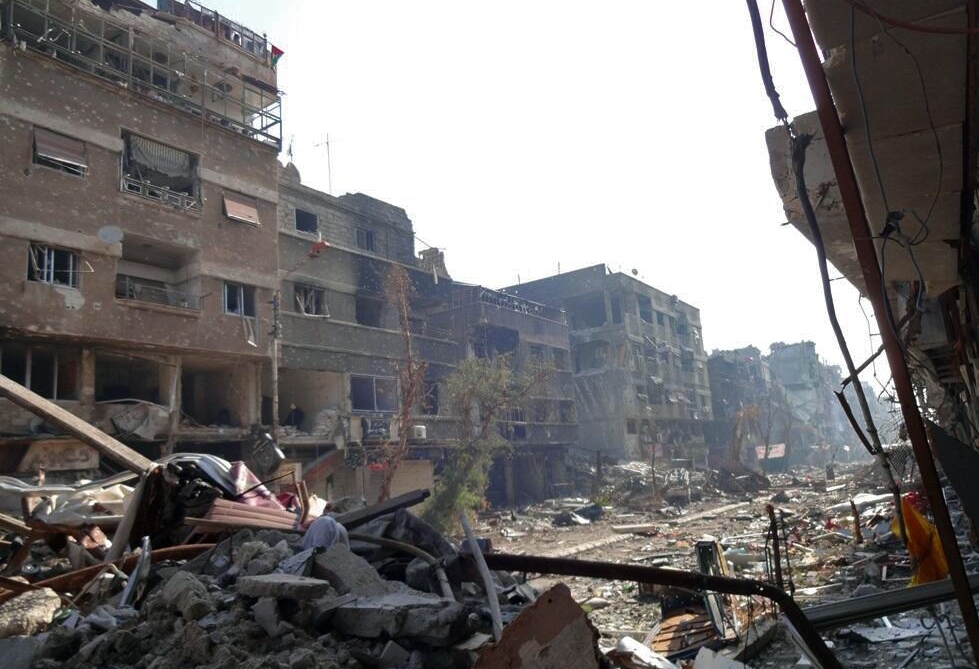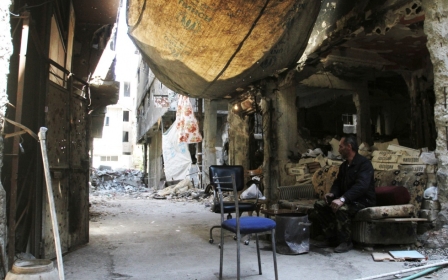UN refugee school in Yarmouk defenceless against barrel bombs

On Sunday, 4 October, two barrel bombs were dropped on a school run by the United Nations Relief and Works Agency (UNRWA) for Palestinian refugees in the besieged Yarmouk camp in southern Damascus by a Syrian government helicopter.
“Four other barrels were dropped on different inhabited areas of the camp. As usual we heard the helicopter’s sounds while flying in the sky, and the sound when the barrels collided with its targets,” Ayman, an activist in Yarmouk told Middle East Eye.
Ayman added: "Thank God, losses were limited to material things and no casualties were reported. Just a few metres away from the school, there are three families living in one building. It was possible a massacre could have occurred."
More barrels were dropped by the Syrian government’s helicopters on the camp two days later. One victim was killed, just two weeks after his wedding, four were injured and there was mass destruction, according to Facebook page “Al-Yarmouk Camp News.”
According to the Action Group for Palestinians in Syria (AGPS), it's not the first time an UNRWA school or a health centre was targeted in Syria.
UNRWA, until now, has not commented on the attack.
Alaa al-Barghouti from AGPS told MEE that an UNRWA school in Yarmouk where many internally displaced persons (IDPs) were taking shelter was hit by a MiG airplane in December 2012. There were dozens of casualties among the civilians. "Being at an UNRWA school didn't protect them. We all heard the scary sound of the aeroplane in Yarmouk’s sky and then the sound of the bombing,” al-Bargouthi said.
Earlier this year, there was another attack on an UNRWA facility in Khan al-Sheh camp for Palestinian refugees. This camp is not under the control of the Syrian government and has “no presence of rebels inside it,” emphasised Abu Diab, a retired teacher. “Even if there is some military opposition in our camp, this doesn’t justify the regime bombing us,” the teacher added.
UNRWA, in a statement about the attack, condemned the parties responsible for the "fatal explosions,” stating, without determining them: “One Palestinian refugee was killed and an unconfirmed number were injured. The injured included at least one child who had been participating in summer activities in an UNRWA facility when a large explosive directly hit an UNRWA school next door, destroying the building. The school had not been in use for many months.”
“We all know that the side that has planes in Damascus and around it is the regime. We all know that the regime is bombing us with barrels and mortar shells. Why UNRWA didn’t refer to the regime in their statement, why they hid the truth? If they don’t believe us, we ask them to send international observers to our camp,” the retired teacher angrily added.
The statement added: “Khan al-Sheh camp was hit by several explosive munitions over the course of the day on 16 June, first at around 1am by what was believed to have been mortar shells. Then around 11:30am the camp was hit by heavy munitions reportedly including at least one barrel bomb delivered by aircraft.”
Al-Barghouti from AGPS said: “UNRWA doesn’t do anything but release condemnatory statements. Nothing else is done to protect the Palestinian civilians in the Syrian camps.”
Amal Jaradat, a Palestinian nurse who works in the Muzeirib neighbuorhood for Palestinian refugees, which is under control of the Syrian opposition 11km northwest of Deraa in southern Syria, told MEE about two other attacks near UNRWA‘s school last year, which were 18 days apart.
“We received more than 35 injured school children in our medical clinic and there was only one doctor and five nurses and paramedics. We were out of bandages, which are in fact limited because our area is out of the regime’s control and the medical supplies are prevented even for the civilians,” Amal, the 27-year-old nurse, told MEE.
She added: “The second attack was the most horrible. 18 civilians were killed, among them six school children, while more were injured. I can’t forget the hysterical crying of a 12-year-old when he saw his leg was amputated.”
The former general commissioner of UNRWA commented on this attack: “I must express my revulsion at this wanton disregard for civilian life and international law.”
Clearly, the government from the beginning does not differentiate between the Palestinian refugees camps and the other Syrian sites, and doesn’t give the Palestinian refugees issue in Syria any special observance.
Regarding the motives which maybe behind bombing UNRWA schools in Syria, Ahmad Al-Sholi, a Palestinian researcher in strategicstudies and an expert on Syria based in New York, told MEE: “This regime went to the extreme end in destroying the country it rules because the population revolted against its autocratic police state. It got a free pass and it’s using it to its full potential, destroying everything in the country to evade any possible capacity building for the population under assault, while the claims of militant groups using these facilities is similar to those of Israel when it escalates against Gaza.”
Al-Sholi added: “Just as in the case of Israel, where the UN proved to be useless so far in providing basic guarantees and securities to different populations that fall under its rounds of attacks in the region, Syria albeit with a lower leverage than Israel, continues to violate all international laws because of its geopolitical alliances that shield it from UN mechanisms. In such a position, the Syrian regime gets a free pass in responding to the revolting Syrian population, targeting people taking refuge in schools that supposedly enjoy some international status, which makes them viable options for a population suffering under extreme war conditions in the first place.”
Before the war in Syria, more than 500,000 Palestinian refugees lived in Syria in many camps and neighborhoods. Many of them have now fled to Lebanon, Turkey, Jordan or Europe after their neighbourhoods became battlefields. According to UNRWA, of the 560,000 Palestinian refugees registered in Syria, some 480,000 remain in the country, of whom 280,000 are internally displaced. Some 44,000 have fled to Lebanon while another 15,000 have gone to Jordan.
Middle East Eye propose une couverture et une analyse indépendantes et incomparables du Moyen-Orient, de l’Afrique du Nord et d’autres régions du monde. Pour en savoir plus sur la reprise de ce contenu et les frais qui s’appliquent, veuillez remplir ce formulaire [en anglais]. Pour en savoir plus sur MEE, cliquez ici [en anglais].




